When we began planning our wedding, we knew we had to decide how it would be documented. Of course, we knew we wanted to have a photographer, but we also loved the idea of our guests contributing in a unique way to the memorabilia. We thought about providing disposable cameras, researched renting a photo booth (it’s very expensive), and even considered buying some old video cameras and some 8mm film to allow our guests to get some moving images. Somehow none of it felt quite right (or affordable).
On top of that, of course, was the fact that we were aiming for a Gatsby-esque, garden party vibe to the affair. It wasn’t the strictest of themes, but we did want people to feel, even for just a moment, that they had stepped back into another era.
Finally, in a “why didn’t we think of that before!?” moment, it hit us: We’d build a 1920s-style paper moon backdrop, set up a camera with a remote control, and let people take dreamy, starry photos of themselves!
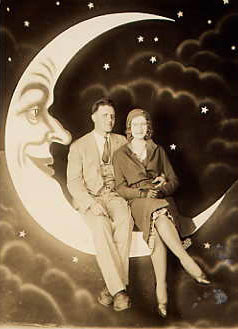
A paper moon
While information is a bit hard to come by (on the internet, anyway), it seems that paper moon pictures were popular in the early part of the 20th century – especially in the 1920s and 30s. To achieve these floating-in-space images, a painted background and set were created in a photographer’s studio (or a circus tent or a booth on a boardwalk) and an individual or group would be arranged to look as though they were sitting upon the crescent moon. Some settings were simple, barely realistic, with nothing more than a moon painted on canvas (or perhaps paper, I suppose) while others included multiple layers of clouds and stars.
We had intended for our paper moon to be a self-serve, photo-booth-style affair, but when we asked our photographer for some advice on setting up a camera, flash, and remote, he loved the idea so much that he offered to take the photos himself!
With the photography logistics in very capable hands, we were able to turn our attention to designing and building a paper moon. For the sake of anyone wishing to have a paper moon at their wedding too, I will go into some detail about how we did it. You CAN do it yourself with not much time or money spent. If you have questions that aren’t addressed here, please get in touch and I’ll be happy to help if I can.
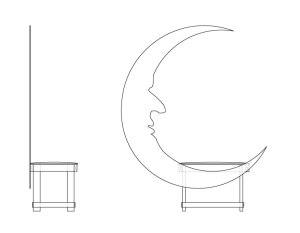
Paper moon drawing (shown without the grid or dimensions; both are important)
Design
First, as with most aspects of our wedding planning, we spent a good deal of time doing internet research. We collected a number of vintage photos and decided what we liked (or didn’t) about each. From that exercise we had a pretty good idea of what we wanted our moon to look like.
Next, I set to work sketching the construction details — first on paper and then on the computer. I created a fairly simple construction drawing for us to work from, then I created a grid (not shown here) over the image and printed it to scale to make the transfer from paper to plywood more accurate.
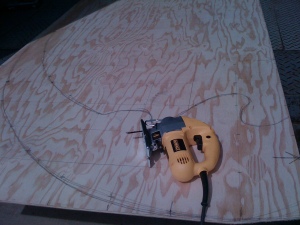
Plywood with grid layout and the moon taking shape
Construction
Our first step was to transfer the shape of our moon. On a sheet of plywood, I created a series of 6-inch squares to create the grid to match the one on our drawing. Creating a pencil mark at each point that the outline of the moon crossed a grid line gave me the initial shape. Then, using a bit of freehand drawing, I connected those points, matching the drawing as accurately as possible.
Our moon was rather large and so required two sheets of plywood. Before drawing the moon on the wood, I lined up both sheets and created reference marks (the arrow at the right in the photo) to be able to line up the pieces later. Make sure that your reference mark(s) land inside the moon and not on the scrap portion of the plywood.
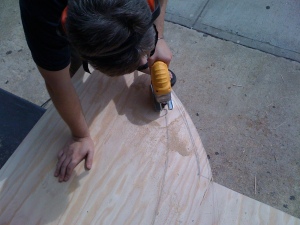
Cutting out the moon
Once the moon’s outline was transferred to the wood I simply followed the lines with a jigsaw and our moon’s shape was complete! (Please use proper safety equipment when using power tools — in this case, eye and ear protection are a must).
Obviously, a simple moon-shaped piece of plywood will only get you so far. You’ll also need some sort of seat upon which the photo subjects will sit.
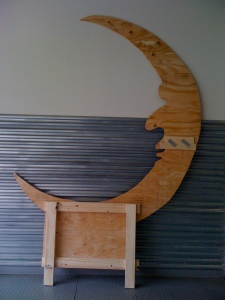
Assembled moon with the front of the bench attached
I’d devised a bench that would be built along with the moon, but because we needed to transport the moon in a car (it just barely fit into our rented SUV it turned out – whew!) it needed to come apart and be re-assembled on site. In order to keep the number of pieces to a minimum, I opted to permanently attach the front portion of the bench to the moon. I built this out of 2×4 legs attached with 1x3s held together by trusty drywall screws.
Because our moon was created out of two pieces of plywood (try to use one if you can, it simplifies things) we needed a way to connect the two pieces. We accomplished this using rectangular steel plates and screws. It was a little wobbly, but it did the trick.

Assembled bench framework
To finish the bench framing, I cut two more legs from the 2×4 and screwed it all together with the 1×3 cross pieces. In hindsight, this bench could have used some diagonal bracing, so, if you build one, I’d recommend adding that to the design.
As you can see in the photo, I labeled all parts carefully as I constructed them to ensure that we’d be able to get the moon back together properly at our wedding venue.
In order to make things a bit more comfortable, we added an upholstered seat. We cut another piece of plywood, some batting, and some faux leather cloth to size, and stapled it all in place. We cut the batting and cloth large enough to overlap the plywood to ensure splinter-free edges and allow us to staple it all to the bottom of the seat. After these photos were taken, I added another, smaller piece of plywood to the bottom of the seat that was notched in the corners so that it fit inside the bench frame and we could secure the seat from sliding sideways.
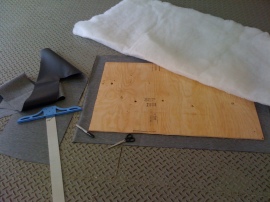
Seat material
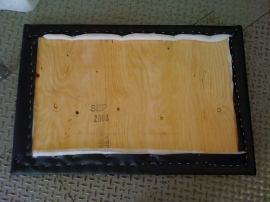
The [bottom of the] finished seat
Finishing
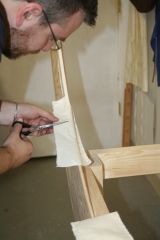
Applying muslin to the rough plywood edge
In order to create the illusion that a person is sitting in the moon, the seat needs to be behind and slightly below the moon itself. The only problem with this is that the seated person’s legs, draped over the edge, will touch the rough edge of the plywood. Knowing that folks would be in their finery, we decided we’d better finish that edge somehow. To start, we sanded the edge (in fact, we sanded all of the edges as well as the front face of the plywood to create a smooth surface for the paint). Then we applied strips of cotton muslin over the edge with watered-down white glue. This created a safe (and also paintable) edge at the bench.
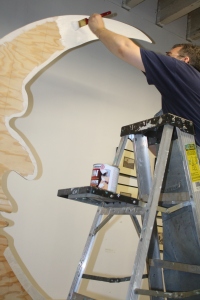
Priming the moon
Next we smoothed out the face of the plywood for painting by filling all of the holes, cracks, and gaps with Spackle and sanding everything again. Once the Spackle was dry and we’d brushed all of the sanding dust off, we applied two coats of primer to the moon’s face in preparation for its final paint job.
At this point, our work was done so we stepped back and let the primer dry. Alessandra’s cousin (an illustrator and puppet designer who currently works for Sesame Workshop) had agreed to do the final paint job of the moon — which, as you’ll see below, was an incredible gift.
Final Painting
Cousin Matt came by a few days later with his paints, brushes and some reference material and set to work.
After just a short amount of time, the real moon began to appear.
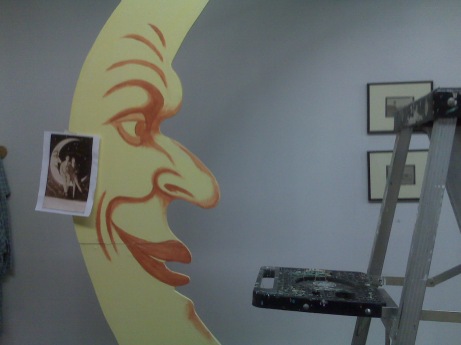
The moon emerges…
Soon the finishing touches were added and the moon was complete!
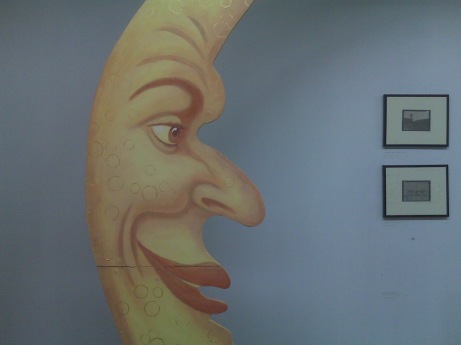
The completed moon
Wedding day!
One thing that we loved about the paper moon photos we’d seen is that no matter how well executed they are, they still look a little phony. To embrace that, we decided to cover our black cloth backdrop with planets, stars (both shooting and stationary), and the occasional rocket ship made of cardboard painted silver. These we pinned haphazardly to the cloth and we were set to go.
Most of our guests posed with the moon and had fun with it. Not only did this give us a unique set of photos of the day (in addition to our “traditional” photos), but we were able to print and frame many of them and give them as thank-you gifts to all of the friends and family that helped to make our wedding perfect.
We printed and framed ours as well and it hangs in our house as a happy reminder of the day, the fun we had researching and creating elements that felt very much “us”, and the handiwork of so many people who helped us put the day together.
UPDATE: We just learned that our excellent wedding photographer, Toby Morris, has started a new venture: Fantabulous Photobooths. Check out his new website at www.fantabulousphotobooths.com.

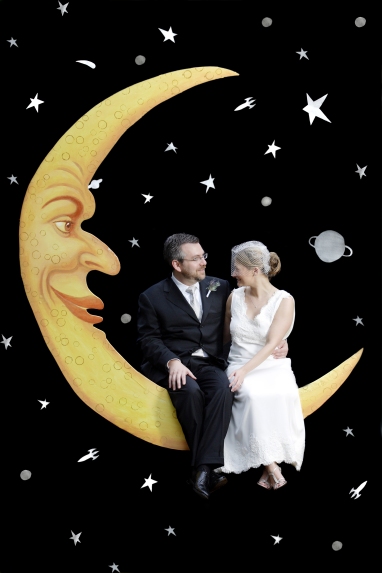

So fun! The booth turned out great and I bet your guests were over the moon about it 🙂
Thanks! Yes, everyone had great fun posing in the moon. We’re so glad we did it.
Wonderful story, and a lovely attribution for Cousin Matt.
Im trying to make a paper moon for my wedding as well! Yours looks fabulous. What is the black background made of? And how did you attach it/hide the bench all while keeping the black areas ‘smooth’ looking?
Excellent! The black background was a piece of black cloth – it was either commando cloth or Duvetyn. This fabric is typically used as masking curtains on stage. You can get it from (among others, I’m sure) Rosebrand (www.rosebrand.com). If you’re doing this indoors (we were not) get enough cloth to extend under the moon for a smooth transition (just be careful not to make a slippery surface where people will walk). For the bench, we painted all of the surfaces that would be facing the camera flat black. In the end we needed to use a little bit of Photoshop to clean things up – mostly because our moon was on the ground outdoors without black cloth underneath.
I sure hope that helps! Have fun!
Your idea is so cool – but so time consuming. My daughter and future son-in-law are being married in Oct. 2013. Any chance you’d rent out your “equipment” They both have jobs that take up almost 80 hrs of each week and there’s no way they could find the time or energy to make something so time consuming a reality. They are NYC residents. If you have any interest – pls. email me. Thanks!
We ended up making a paper moon for our September wedding, and it is fabulous! My mother is an artist and she painted it herself. I would be willing to rent it out, but I live in Oklahoma, so shipping might be pricey. If you are interested in looking into shipping costs, let me know and I’ll see what I can do.
This is such an inspiring project and the final photo is stunning. I have always been a fan of these booths. This post described the process in such perfect detail, so thank you for that! I have a few questions about the background… Do you know how much fabric was used for the background?And how did you attach the silver cardboard to the fabric? Thank you!
Thanks so much, Sarah! I’m glad this was helpful. As I recall, we used two pieces about 4 yards long (I think the standard width is 52″). If you can, I would greatly recommend setting up the camera that you plan to use in the space and note what you can see through the viewfinder. That will give you an idea of what you need to cover with the cloth.
As for the stars and moons, they were held on with safety pins that we’d taped to the back – cheap and easy! You could also use double-sided tape or velcro squares.
Good luck!
Thank you so very much for your response! Two more small questions if you have time:
Did you use scrap cardboard or a chipboard of some kind for the shapes? And did you sew the fabric panels together? Thanks! (Also, I studied Printmaking in college , so this Paper Moon booth helped me discover your amazing Letterpress work!)
We simply used scrap cardboard. Anything that is fairly rigid will work – old cereal boxes for example. We didn’t sew the fabric at all. We just overlapped the two pieces a bit. On the outer edges we left them unfinished as well knowing that they’d be outside of the photo.
Hope that helps!
What size is the moon? I didn’t see any dimensions listed?
The moon that we made ended up to be about seven to eight feet tall, I think. I’d say that you could adapt this design to whatever size will work for your venue (and camera).
Good luck and have fun!
Beautiful story and a special project. You have inspired to make one for an indoor June banquet using sun and moon decorations. Please help me understand your height and width measurements and how you had to balance them with the bench? Was the bench width a standard width (like a piano bench) or did the bench size depend on the moon template you created?
Do you remember where you found the graphic you used? It’s so lovely.
Thanks! I’m so glad we’ve inspired you!
The bench size was based on allowing two people to sit side by side as well as adding enough ballast to keep the moon upright. In retrospect, I would have made the bench heavier (though not bigger) and would have added an additional brace from the top of the moon straight back and down since it tended to wobble a bit. Since we had to break ours down and transport it those things weren’t really possible.
To make your life easier, you could alter the design to work around a bench (piano or otherwise) that you already have. The only thing about that, though, is that when people’s feet cannot touch the ground when sitting on the bench it makes the effect of sitting in the moon work a bit better. Since you’ll be indoors, consider using the wall or ceiling to secure the moon. Our slight wobble didn’t impact the photos but made some people a little uncomfortable on it.
I drew the shape of the moon myself but based it primarily on this one: http://bit.ly/mB1njv
Good luck with your moon!
Wow, thanks very much for putting this together! We have just started work on our own Paper Moon scene to hire out in the UK as part of our photo booth rental service. Our execution and background will be a little different but there’s a couple of tips in this article that has surely saved us making a couple of mistakes with the construction. All images will be up on our website as soon as the build is complete: http://www.blooperphotobooths.co.uk Thanks again!
I’m glad it helped!
We did it! Our Paper Moon has been to its first event and it was a massive hit. Can’t wait to take it out again! http://www.blooperphotobooths.co.uk/scenes.php Please take a look, click on Paper Moon for full size images. Thanks again Lucky Duck.
Pingback: Let’s Go Out and Feel the Night: This Weekend’s Supermoon | The Year of Halloween
Love your Moon! Could you please tell me how high your seat and moon was from the ground. Did you need some kind of stool to assist people to the moon seat? Also, how did you hang your black cloth? Was it hung on something? Were your pictures taken at night so there was not any reflection from the sunlight or did you have something to block the sunlight from above the moon set. I really love this look and would appreciate your help in making one myself. What a wonderful wedding picture.
Thanks Susan!
Our seat was about 24″ above the ground. Looking in hindsight, I’d say that was a little too high. 18″ would probably be better. The moon, itself, was about 8′ tall. We really went big with it but a smaller moon would still work and be much more manageable.
Our wedding was in a covered pavilion in a park. We set the moon up just outside and hung the cloth from the roof which was just a few feet higher than the moon. Even then, we did not have quite enough cloth and needed to fix the background a little with Photoshop after the fact. It was set up during the day but it was a very heavily overcast day so the sun was not an issue for us.
I hope this helps! Good luck!
Pingback: How to Throw a Great Gatsby Party, Part 2
how big was the plywood?
Hi Dani,
We used two standard 4′ x 8’sheets of 1/2″ plywood.
My dad and I would love to make this for his parents 50th wedding anniversary party. Is there any way we could get a close up picture of just the moon?
Thanks
Hi Emily,
I looked through my photos and the pictures that I’ve included in the blog post are really the best I have of the moon alone.
Good luck!
Just about finished with my moon booth!
Thanks for the help!
No problem! Enjoy.
Any chance you would have a paper template of the moon?
Hi Carl,
We never made a template for ours. We used a scaled drawing and transferred the shape freehand onto the plywood with pencil. Then we just cut along the shape.
Good luck!
May I know how do you fix the moon on the backdrop?
Hi Renee,
The moon and the background are actually not fixed together. The background simply hangs approximately 18″ behind the seat of the moon.
I hope that helps. Good luck!
Thank you for clear my doubts! Thanks.
Looks great! I’m trying one myself and I’m wondering what thickness of plywood you chose to go with. I’m trying to find a middle ground between too flimsy/delicate and so heavy it’ll collapse under its own weight. Any suggestions?
Yes, that is a choice we struggled with as well. With a moon as tall as ours, stability was a concern but, as I’ve mentioned, it needed to be transported. I believe that we ended up with 1/2″ plywood. I would say to go thicker than that if you can bear the weight (and cost). That said, ours didn’t fall down. Though no doubt some additional support – straight back to a wall or even angled down to the ground – would have help a bit of our wobble.
Good luck and have fun!
Hi! I plan on building a similar moon for my upcoming wedding and was wondering if you recalled the dimensions for this plan? I would so appreciate it! Thanks! -Cory
Hi Cory,
The total height of the moon was about 8 feet (including the seat) and it was about 6.5 feet wide.
Have fun and good luck!
Pingback: 10 Stunning Photo Booth Backdrops – Sarah Young
Thank you for this information! I’m building one for my sister’s Gatsby themed 30th Anniversary and your DIY tutorial makes great sense!!!
Sounds like a great party! I’m glad we could help!
Hello! I love the shape of your moon, its exactly what my friend wants me to replicate (without the face) for her wedding. You mentioned you did a grid which was important. Both my friend and her fiancé are very tall so i would like to keep the dimensions the same as yours with the two pieces of plywood. Would it be possible for me to get those from you?
Also did you need to anchor the legs of your seat bench somehow? They will be in a wedding venue so unable to screw to/anchor to the floor in the case of the moon tensing to lean forward. Did you guys find you had any trouble with that? If so any suggestions ?
Thank you for your time!
Hi Rachel,
Our moon was just about 8′ tall (maybe a little more) and this worked really well for our guests. As for securing it, ours was a little wobbly at the top. We didn’t attach it to anything but the legs of the bench sank into the dirt (outside) a little so that helped. Indoors, I would suggest trying to secure it to something (outside of the picture) or add weight to the base. I think a couple of exercise weights would do the trick – or even a couple of gallon milk jugs filled with water. Attach them to the bench or create a low shelf to put them on and I bet it’ll be stable.
Good luck and have fun with it!
Hello,
Thanks for all of the information! Would you share how you attached the moon to the bench? Did you have to drill screws into the front of the moon?
Hi Angie,
We did screw the moon to the base from the front. There was an area in the moon cut out that was outside the shape of the moon that we left and painted black (you can sort of see it in the photo of the assembled but unpainted moon). That allowed us to screw the parts together and then paint over the screws.
I hope that helps!